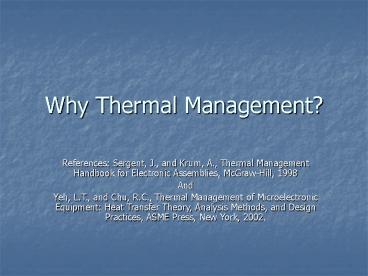Why Thermal Management? - PowerPoint PPT Presentation
Title:
Why Thermal Management?
Description:
Why Thermal Management? References: Sergent, J., ... (non-temp-related) failures Due to mechanical interconnections: poor wire bonds, die bonds, lead frame bonds ... – PowerPoint PPT presentation
Number of Views:124
Avg rating:3.0/5.0
Title: Why Thermal Management?
1
Why Thermal Management?
- References Sergent, J., and Krum, A., Thermal
Management Handbook for Electronic Assemblies,
McGraw-Hill, 1998 - And
- Yeh, L.T., and Chu, R.C., Thermal Management of
Microelectronic Equipment Heat Transfer Theory,
Analysis Methods, and Design Practices, ASME
Press, New York, 2002.
2
Size and Performance Trends
- Higher levels of integration in semiconductors
- More multichip modules
- Faster speeds, smaller devices
- Leads to both more heat generation and higher
heat densities
3
Increase in Circuit Complexity
Yeh and Chu, 2002
4
Major Causes of Electronics Failures
Yeh and Chu, 2002
5
Types of Failures
- Soft failures Properties change, changing
performance outside the specs
- Resistors, capacitors, transistors, leakage
currents - Example bipolar transistor gain can change by
a factor of 3 over the military temperature range
Sergent and Krum, 1998.
6
Types of Failures, cont.
- Hard failures component doesnt work at all
- Corrosion, chemical reactions, intermetallic
compound formation - Cracking caused by different coefficient of
thermal expansions - Breakdown of materials
7
Classification of Temp-Related Failures
- Sergent and Krum, 1998.
8
Yeh and Chu, 2002
9
Other common (non-temp-related) failures
- Due to mechanical interconnections poor wire
bonds, die bonds, lead frame bonds, etc. bonds
not fully formed or incompatible materials - Due to manufacturing defects in active devices
impurities in semiconductors, pinholes in
insulating oxide, etc. - Due to electrical overstress overstress during
operation or else exposure to electrostatic
discharge - Due to chemical reactions corrosion or formation
of intermetallic compounds exacerbated by high
temperatures
10
Designer Reaction to Thermal Issues
- Two common reactions
- Underestimate of component temps, resulting in
too little cooling, leading to failure - Overkill cooling a system much more than
needed, leading to excessive cost and increased
size and noise - To properly design the system, we need to know
the following - How and where heat is generated
- How to estimate the temperature
- How to remove the heat
- Well focus on these three issues in class!































